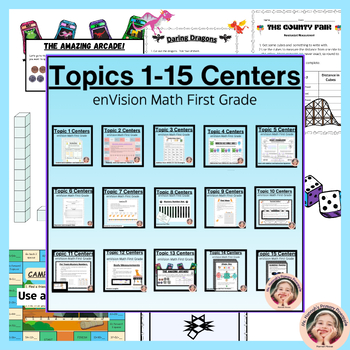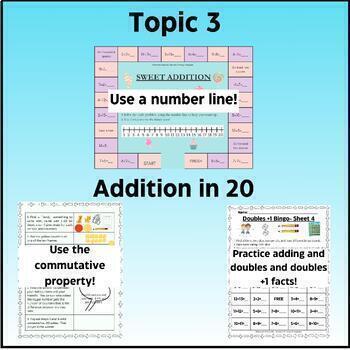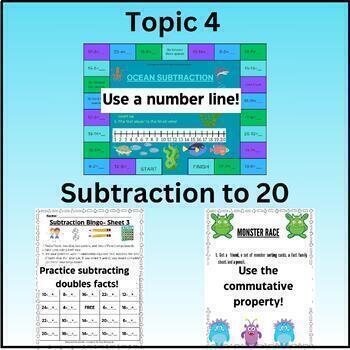All Year enVision Math Centers + Games First Grade 1st Grade Topics 1-15 Bundle
Hannah Hoose- Ms Hannahs Primary Pineapple
37 Followers
Grade Levels
K - 2nd, Homeschool
Subjects
Resource Type
Standards
CCSSK.CC.A.1
CCSSK.CC.A.2
CCSSK.CC.C.6
CCSSK.MD.B.3
CCSS1.MD.A.1
Formats Included
- Zip
Pages
254 pages
Hannah Hoose- Ms Hannahs Primary Pineapple
37 Followers
What educators are saying
My students loved using this resource for centers. They love to do guess who with the hundreds chart.
Products in this Bundle (15)
showing 1-5 of 15 products
Bonus
Wags and Fuzz- A Differentiated, Decodable, First Grade Reader's Theater Script
Description
These centers have been carefully aligned with the 1st grade enVision Math and are specifically designed to be utilized during step three of the program. To reinforce the taught concepts, I employ these first grade math stations in small group settings for reteaching purposes. Furthermore, I laminate the materials or put them in slides to enable students to work on them independently. This product covers main ideas in all first grade CCSS standards- topics one through fifteen. Inside, you will find:
- The Duck Pond- A game focused on using manipulatives to separate ten ducks in two groups- some in the pond and some on the grass- and then write a subtraction equation and draw a picture.
- Pet Treats- An engaging activity for students to practice joining by giving treats to two pets and adding them together and drawing a picture.
- The Comparing Game- Two players build numbers with cubes and find the difference between them.
- Bunny Hop Addition and Space Subtraction- Board games focused on using a number line to add and subtract within 10.
- Doubles and Doubles +1 Tic Tac Toe- Engaging games for students to practice writing equations with doubles.
- Five Alive- Two players build numbers with ten frames and counters and find the difference between them. They practice writing equations using the commutative property.
- Sweet Addition: This board game emphasizes the utilization of a number line to facilitate addition within the range of 20.
- Doubles and Doubles +1 Doubles Bingo: These partner games aim to solidify skills related to doubles, specifically within the range of 24. Each game consists of four distinct bingo sheets.
- Anchoring Ten: In this activity, two players utilize ten frames and counters to construct numbers ranging from ten to twenty. They then determine the difference between the numbers and practice writing equations utilizing the commutative property.
- Monster Race- A matching and sorting game to practice fact family skills.
- Ocean Subtraction- A board game focused on using a number line to subtract within 20.
- Subtraction Doubles Bingo- Partner games focused on cementing doubles skills within 24. There are four different bingo sheets for each game.
- Crazy Chameleons- A coloring activity to practice using the equals sign.
- Tell the Truth- A pet detective game designed to help students determine whether equations are true or false.
- Get to School Addition- A board game for adding three numbers.
- A shape monster activity involving graphing pattern blocks.
- Two versions of the addition game, where students can review their addition skills while collecting graphable data.
- The difference game, where students solve subtraction problems and graph the differences that they find.
- Counting Games- A variety of games to practice crossing the decade, counting by tens, working with teens, and exploring numbers greater than 100.
- Guess Who- A game to practice asking and answering questions about numbers.
- Race to and from 120- A racetrack game for exploring the number grid.
- Counting Cubes- An activity designed to practice counting the same number in different ways. I have two versions of this center- one page or two pages depending on how much time you have.
- Race to 120-A racing game involving trading ones for tens. It is easily differentiatable for advanced learners with Race from 120.
- Mystery Numbers- A place value game where students build numbers with base ten blocks.
- Twisty Digits- A card game where students make the largest number with two digits.
- Number Comparer- A center designed to practice ordering numbers from least to greatest and greatest to least.
- Guess Who for Comparing Numbers- An activity for helping students to use academic vocabulary.
- Find Wags- A game to practice using tens and ones with the hundred’s grid.
- Camping Addition- A camping themed game involving addition using a number line.
- Alien Mystery Numbers- A place value game for counting how many aliens are in a rocket ship by adding place value blocks.
- Addition Mystery Picture- A coloring sheet for students to practice adding by tens.
- Number Maker- A number sense activity for predicting a sum and then adding dice to see how close you were.
- Surfing Subtraction- a surfing themed game involving subtracting using a number line.
- Pet Treats Mystery Numbers- A place value game involving a cat and a dog sharing treats by subtracting place value blocks. The first two cards have wholes ending in 0, and the second two have wholes ending in a variety of numbers.
- Subtraction Mystery Picture- This is a coloring sheet for students to practice subtracting by tens.
- Number Roller- A differentiated activity for subtracting tens and ones using a hundred’s grid.
- Body Measurements- An activity to practice measuring lengths using body parts as nonstandard units.
- Measurement Scavenger Hunt- Indirectly compare lengths in this fun scavenger hunt.
- Daring Dragons- Order length with adorable dragons.
- The County Fair- Measure the distance between rides at a fiar using cubes or inches as units.
- Race to One Dollar- A game involving trading five pennies for one nickel and two nickels for one dime.
- The Amazing Arcade- A choose your own adventure shopping trip to the arcade using coins. I differentiated this activity for different values of coins from just using pennies to using pennies, nickels, dimes, and quarters.
- The Big Day- A dream schedule for yourself or an animal using analog and digital clocks.
- Time Memory- An activity to practice matching analog and digital clocks. This activity is easily differentiated using time cards to the hour, half hour, or both.
- Shape Scavenger Hunt: A classroom quest to discover the characteristics of various shapes.
- Create a Shape: Design shapes with curves and lines.
- Shape Bag: Identify shapes through the sense of touch and their unique attributes.
- Shape Picture- Draw a picture and chart the geometric shapes that make it up.
- Shape Sort: Sort three-dimensional and two-dimensional shapes based on their distinct attributes. The Brownie Party and The Pizza Party- Partition circles and squares into equal shares while planning a party!
- Fraction Bingo- Color in fractions while playing low prep dice bingo.
- Fraction Dominos- Match fractions while making domino trains.
- Fair or Not Fair- Help Hop the Rabbit cut an equal share of food for all four creatures at her party by sorting cards as fair or not fair.
Total Pages
254 pages
Answer Key
N/A
Teaching Duration
N/A
Report this resource to TPT
Reported resources will be reviewed by our team. Report this resource to let us know if this resource violates TPT’s content guidelines.
Standards
to see state-specific standards (only available in the US).
CCSSK.CC.A.1
Count to 100 by ones and by tens.
CCSSK.CC.A.2
Count forward beginning from a given number within the known sequence (instead of having to begin at 1).
CCSSK.CC.C.6
Identify whether the number of objects in one group is greater than, less than, or equal to the number of objects in another group, e.g., by using matching and counting strategies.
CCSSK.MD.B.3
Classify objects into given categories; count the numbers of objects in each category and sort the categories by count.
CCSS1.MD.A.1
Order three objects by length; compare the lengths of two objects indirectly by using a third object.





